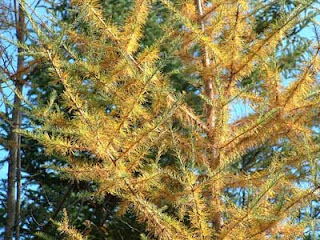
Most children learn that conifers are often called "evergreens" because they don't loose all their needles in the fall. However there is one beautiful exception to this rule. . . the Larch also known as the Tamarack. Every fall the Larch paints the landscapes it inhabits with a beautiful yellow as it loses its needles.
Larch is not a major commercial timber species. However, in recent years its appeal has increased particularly for use where dampness is an issue (decks, sills, walkways, bridges, posts, poles, mine timbers, and railroad ties). In the US it is still used primarily for pulpwood. Unlike most other conifers, it is a goood fuelwood because of its density.
Food For Mammals: Snowshoe hares feed on twigs and bark; porcupines love the inner bark; red squirrels the cones; mice eat the seeds. Though the porkys love the bark it seems to taste bad to deer and moose, who avoid it even in the worst of winters.
Bird Food: Larch is a food source for some species of Grouse, Pine Siskin, Crossbills, and some other birds.
Native Americans used the roots for making cord, they also used the wood for arrow shafts, and the bark for medicine. The roots were specifically used by Ojibwe people for sewing the edges of canoes and making woven bags. Native also taught the first european settlers to use the soft needles for pillows and mattress stuffing (though they rarely used such things themselves).
Medicinally the inner bark was used to treat depression.
Larches & Geese Mindscape

No comments:
Post a Comment